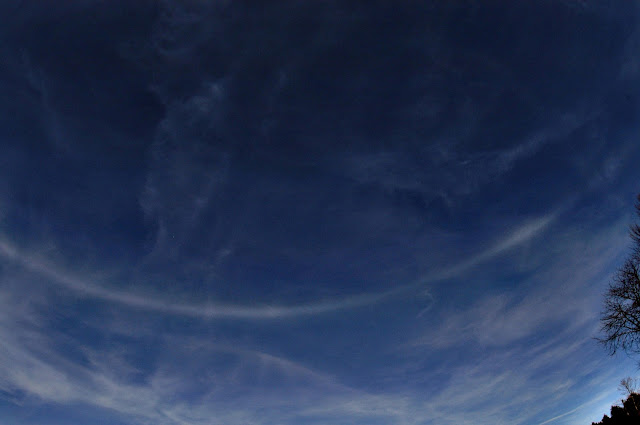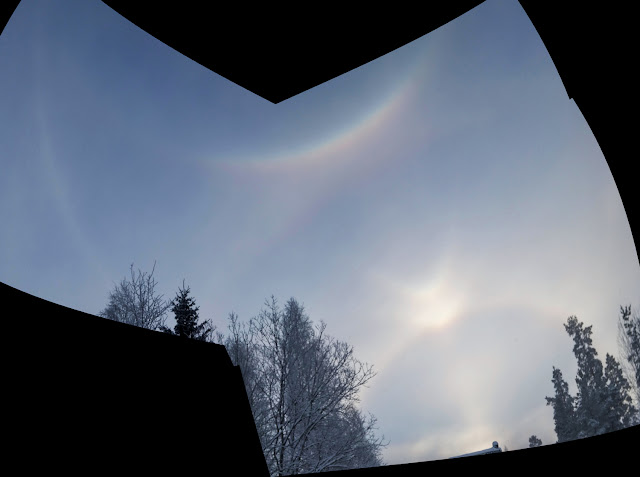Seems like the rare halos keep coming. While visiting my brother and his family I was outside his house watching this halo complex evolve. In terms of rare halos I got parry, 120d parhelia, Wegener arcs, blue on parhelic circle. While enhancing pics and I saw it in pics afterwards an inverted V shaped arc outside the parhelic circle. Could this be hi-sun Tricker arc?
Marko Riikonen what do you think?
Monday 19 February 2018
Saturday 17 February 2018
Cult of the Natural?
Occasionally, I get the impression, rightly or wrongly, that some observers consider halos which have been produced by spotlights to be in some way ‘inferior’ or ‘artificial’ when compared to those which have been produced either by the sun or moon. This position is never explicitly stated but is, rather, vaguely hinted at as if there is some unspoken ‘cult of the natural’ operating in the background. The purpose of this post, therefore, is to pose a few questions to our readers and to solicit their thoughts and opinions on the matter.
For example, do you think that ‘natural’ halos produced by the sun or moon are in any way better than those produced by a lamp? In this context, what do we mean by ‘natural’ and ‘better’? Likewise, are we to consider halos produced by a lamp to be in some way 'inauthentic' or unworthy of our attention? If that is the case, on what do we base our conclusion? Then again, is there really an inherent dichotomy between ‘natural’ and ‘artificial’ in this regard or is the light source completely irrelevant? Finally, are lamp generated halos merely tolerated or deemed acceptable only in the absence of a solar or lunar equivalent?
My own position is that I don't really have a problem with spotlight displays. Whilst I am always pleased to see a good quality solar or lunar display, I consider halos produced by spotlights to be equally valid and at times arguably necessary in the pursuit of the highest level of halo research. Indeed, I would suggest that lamp work has the additional advantage of repeatability (given the presence of the right crystals) and also that an observer can adjust the elevation of the lamp to produce specific effects; such flexibility would simply not be afforded to those who opt for a ‘natural’ only light source approach. Historically, many halos would not have been discovered if it were not for the adoption of this technique, rather they would have remained theoretical possibilities. In this way, I think it is reasonable to suggest that lamp generated halos have demonstrably accelerated halo research.
In closing, I offer above and below two images for your consideration. They were both taken by Marko Riikonen, the world's foremost exponent of the spotlight technique. The display was photographed on 5th/6th November 2008 in Rovaniemi, Finland, one set taken during the night using a lamp, the other set taken the following day. Both images were photographed in roughly the same location and the swarm responsible for the display had remained fairly stable during the intervening period to facilitate this comparison. The images are virtually identical, the only difference being the light source in each case. Are we to conclude then that the daytime images are superior to those taken several hours earlier during the night? Is there really a qualitative difference between the two or is the 'cult of the natural' just a psychological construct? Your comments and opinions as always are greatly appreciated.
 |
| © Both images Marko Riikonen |
Saturday 10 February 2018
Elliptical Halo, Lapinjärvi, Finland 23rd January 2018
Following hard on the heels of Michael Ellestad's recent elliptical halo sighting, we have this little gem observed by Mirko Lahtinen in Lapinjärvi, Finland on the 23rd January 2018. Mirko says the halo appeared at about 11.31am in a kind of low level haze and lasted for about ten minutes in total. Ambient temperature at the time about -15°C and images taken on a Motorola MotoG3.
 |
| All images copyright Mirko Lahtinen. |
Saturday 3 February 2018
Project Kern Update
Just under a year ago, we launched Project Kern, the aim of the project being to “try to photograph as many Kern arcs as possible [in a twelve month period]…. to better understand their frequency and to ascertain whether they really are the rarest of the rare”. I am very pleased to announce that almost at the end of the allotted twelve month period of the project we have received our first Kern.
On 20th January 2018, Pasi Vormisto observed an excellent halo display whilst driving just outside the town of Nokia close to the city of Tampere in Finland. Upon finding a suitable parking spot, he managed to document the whole of the display and in so doing photographed several rare halo forms including Tape arcs and 44° parhelia. However, of great interest to us is the Kern arc which appeared in a couple of the frames. One of the characteristics of this particular example is how bright it appears to be. It is readily visible without any additional processing and one wonders whether it would have been visible to the naked eye or in a mirror. One might also speculate as to what kind of monster this would have become if a sequence of images had been taken on a tripod for later stacking. However, every credit must been given to Pasi for even remembering to photograph the area around the circumzenithal arc. All too often, observers become transfixed by all the ‘action’ occurring in the immediate vicinity of the sun.
So then, can we draw any tentative conclusions? I think the jury is still out, but on recent evidence it seems as though they are appearing once or twice per year. For example, in 2015, we had Eresmaa’s two UK Kerns and in 2016 we had Riikonen’s daylight Rovaniemi Kern. Of course, we don’t know how many actual Kerns there were that went unobserved/un-photographed. Although Project Kern is now drawing to a close, there is still time to add to our grand total of one. If it has taught us anything, it is the need to encourage as many observers as possible to routinely photograph the area around the zenith and better still to stack their images. In this way we may better understand their frequency and distribution.
 |
| All images copyright Pasi Vormisto. |
Subscribe to:
Posts (Atom)
















